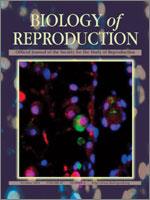The ovarian surface epithelium, a single layer of poorly differentiated epithelial cells, covers the surface of the ovary and is ruptured during ovulation. Little is known about the changes that occur in this layer before or during ovulation, and even less is known about the regenerative processes that occur after the surface is ruptured to release a mature oocyte. Recently, a population of mouse ovarian surface epithelial (MOSE) cells that exhibit progenitor/stem cell characteristics has been identified, though neither a genetic marker nor how these cells are regulated has been determined. We have identified a defined population of MOSE cells with progenitor cell characteristics that express the stem cell marker lymphocyte antigen 6 complex, locus A (LY6A; also known as stem cell antigen-1 [SCA-1]). By testing the effect of factors found in the follicular fluid at ovulation on proliferation, sphere formation, and LY6A expression, we have determined that the size of the LY6A-expressing (LY6A ) progenitor cell population is regulated by at least two ovulation-associated factors present in the follicular fluid: transforming growth factor beta 1 and leukemia-inhibitory factor. Our work has identified a population of LY6A MOSE progenitor cells on the surface of the ovary that may play a role in ovulatory wound healing.
How to translate text using browser tools
3 October 2012
The Mouse Ovarian Surface Epithelium Contains a Population of LY6A (SCA-1) Expressing Progenitor Cells That Are Regulated by Ovulation-Associated Factors
Lisa F. Gamwell,
Olga Collins,
Barbara C. Vanderhyden
ACCESS THE FULL ARTICLE

Biology of Reproduction
Vol. 87 • No. 4
October 2012
Vol. 87 • No. 4
October 2012
ovarian surface epithelium
ovulation
stem cells
wound healing




